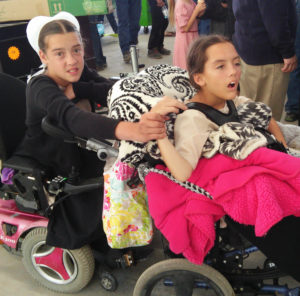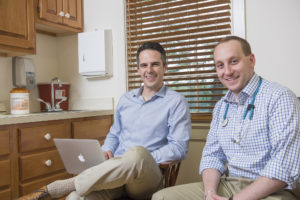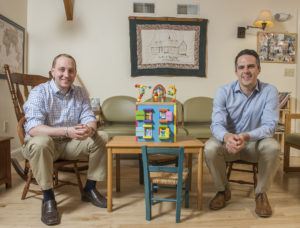Finding a connection with a patient can be a challenge for physicians — especially when dealing with underserved populations.
Fortunately, that is not the case with Dr. Mike Fox — a 2003 Selinsgrove graduate — and Dr. Matt Demczko, who graduated from Mount Carmel in 2004.
The two are on the cutting edge of care with the Amish community — starting in Lancaster County and now via a new clinic in Dover, Delaware.
“When you grow up in the Valley and get used to seeing hitching posts at every Weis Markets, it isn’t as much of a culture shock when you start working with Amish from a medical standpoint,” said Fox. “There was a population of Mennonite kids from Port Trevorton dealing with spinal muscular atrophy, and a new drug was discovered that my hospital was trying to get to the people. When these kids from Port Trevorton travel down, we were able to chat about Hilsher’s General Store and other things just up the road from them, and it helped build a connection.”

Unique opportunity
Fox and Demczko first were introduced to the concept of treating the Amish and Mennonite communities via a class at Franklin & Marshall College taught by Dr. Kevin Strauss that explored ways that cutting-edge technology could be applied to underserved populations.
“Mike was in the very first iteration of the course,” Strauss said, mentioning that the curriculum was “about bridging the gap between medical science and clinical care … and making better use of the avalanche of data generation that really hasn’t reached patients in a meaningful way.”
The two both wound up working with the Clinic for Special Children in Strasburg, a program that specializes in helping members from the Amish and Mennonite communities — among others — deal with rare genetic disorders and other conditions.
“The Amish community is somewhat sheltered, and because of that, there are many diseases that tend to stay within the Amish and Mennonite populations,” said Demczko. “These conditions can be quite complex and difficult to understand. They aren’t well-researched, and that is something we hope to change moving forward.”
Fox agreed.
“We hope to be embarking soon on a project to find more genetic diseases that at hiding or not yet recognized by conducting population-wide gene testing. For example, right now, there is a certain type of heart disease that affects people in the area, but usually doesn’t show up until they are older in adulthood,” he said. “There is another unique genetic disease just discovered in children in Lancaster County that before a few months ago, nobody knew existed.
“These diseases are typically complicated genetic conditions that can affect all parts of the body. They are metabolic and can be prevalent. We are here to bring awareness, research and try to make a real impact.”

Overcoming myths
One of the most challenging aspects to treating Amish and Mennonite families is overcoming common misconceptions that the general public has about these communities.
“There is a myth that the Amish are against modern medicine,” said Fox. “Sure, they choose to live differently than many of us, and they don’t embrace the healthcare community like you or I do, but they are still more than willing to seek out care for a child or family member that is suffering.”
While the Amish are more than willing to reach out for help, Demczko admitted that it has taken time to earn their trust.
“The children here need help, and weren’t really getting it. We tried to fill that gap while proving we weren’t there for financial gains,” he said. “It has taken time, patience and most of all, honesty. We made it a point to be up front and honest with each case, and that has helped us build confidence from these communities.”

Overcoming barriers
One of the most challenging barriers is that Amish don’t have health insurance.
“In healthcare, we sometimes take that for granted, especially when it comes to the tests we order. Everything comes at a cost, and without insurance, that can be a real issue for the communities we serve. Even the labs the rest of us get done on a yearly basis can be a considerable cost for these families,” Demczko said. “We try to limit that when possible. We set a fee schedule at a reasonable rate so that the financial strain isn’t so unbearable that people don’t get the treatment they need.”
In many cases within the Amish populations, tackling mounting healthcare bills becomes a community matter.
“We don’t see anything like it in our society. The community comes together and helps pay for a family that is struggling to make ends meet,” said Fox. “With that, they tend to think things through a little more. They are more inclined to go back to grandparents and community leaders to talk about certain tests or interventions we suggest and look at how they’ll affect not only the patient, but the community, as well.”
Fox admitted that it isn’t that Amish aren’t willing to embrace medical suggestions many of us take for granted, but that it may take a little longer to get to that point.
“Their goal is ultimately deciding what is best for the community as a whole, not necessarily for the individual patient,” he said. “While those in the general community may be less likely to be a test subject for a certain study, the Amish community realizes that the individual may not benefit immediately from the situation, but future generations will.”
The community-based decision process has changed how Fox and Demczko communicate with their patients.
“It requires us to be really open in our communication — we are very specific in describing what are doing and what we are envisioning happening in the future,” Demczko said. “It forces us to have especially open and candid conversations with the families we treat.”
Rewarding results
While finances, communication and the community-based way of thinking may be a challenge at times, both Fox and Demczko aren’t discouraged.
“The general perception is that the Amish and Mennonite are different than us, but when it comes to getting the best care possible, there really is no difference. These people want what is best for their families like the rest of us do — and they want doctors that will talk openly about their conditions and treatment options,” Demczko said. “The Amish and Mennonite are incredibly appreciative of the care we give. They go out of their way to genuinely thank us, and that makes this job so special and rewarding.”
As is the opportunity to work with someone with similar ties to the Valley.
“It is fun to be a part of something new while helping others in a community that really needs it,” Fox said. “To be able to do this with someone else from the Central Susquehanna Valley makes it extra special. It is cool to work alongside a friend like Matt.”
The two challenge each other to push the envelope of care for the communities they serve.
“There is so much to learn yet about caring for the Amish and Mennonite and the unique conditions they are faced with,” Demczko said. “We learn something new each day that helps make our practice better, which helps us make more and more of an impact with those who may need it most.”
